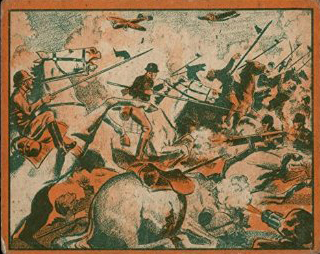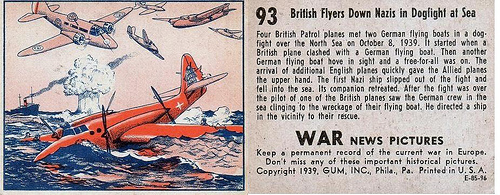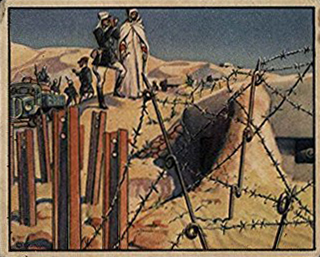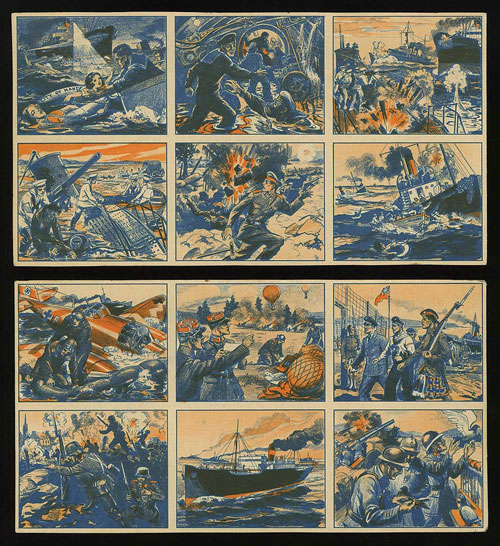The "Dirty Dozen" other War News Pictures!
By Kurt Kuersteiner © 2011 Monsterwax
Trading Cards
The last issue of The Wrapper had a great article about War News Pictures (Gum, Inc., 1939). Daniel Hollandbeck did an excellent job profiling the set. But there are a number of theories surrounding this set that I would enjoy discussing further. They are what make this one of the most interesting non-sports sets ever made (IMHO).

War News Pictures Series D (#73-84)
First off, I’d like to respectfully disagree with a common bias against the art in this set. Some consider it “seriously ugly” or “disgusting”. Dan pointed out they had turned up on a few “worst card sets ever” lists. While it is true that the duotone coloration (especially the orange and green cards #73-84 of series D) is garish and distracts from the art, make no mistake about it: These images were drawn by the same company and artists who drew the beautiful Horrors of War. For some reason, Gum, Inc. reduced the four (full) color process to just two color, and colored the borders orange, drawing the viewer’s eye away from the art. The poor color choices make it hard to appreciate that the illustrations are actually as good as the finest card sets from Gum, Inc. Granted, there are no severed hands clutching a steering wheel, or dogs eating human remains. Bowman seemed determined to make this a less “gory” set than HOW, probably so he could try to pass them off as educational. But why did he forgo using full color on cards that clearly deserved it?
The three obvious reasons are time, money, or both.

War News Pictures Series E (#85-96)
Unlike today’s fancy pants printers, the machines of yesteryear didn’t do four colors in one pass. To create full color, printers had to pass the cardboard through the machine four different times… and each time, the stack had to be set aside to dry to prevent streaking when it passed through the machine for the next layer of ink. My printer prefers two or three days to let them dry. If the same held true for Bowman, that would add another work week to putting on the additional two colors, and that’s assuming they could run all their cards through for each pass in one business day, which could be a false assumption, since Bowman was known to produce hundreds of thousands (if not millions) of HOW cards. The topic was news of the war, as it happened, so there was an added sense of urgency. (HOW was about events that had occurred in the years leading up to 1938, so it wasn’t near as time sensitive.) Keep in mind, that’s only the printing side of things. Having artists add the color would also slow things down, even when done in an assembly line fashion. Producing full color separations and burning the extra two printing plates would also slow things down (not to mention, add to the expense). Now you’re talking two or more weeks for a topic that the newspapers announced the next day, or the radio announced within hours of occurring. You can see why Bowman may have decided to skip this luxury. Personally, I would have preferred simple black and white instead of the clashing orange and green of cards #73-84. But duotone can provide the illusion of color as Bowman demonstrated with the orange and dark blue combination it evolved into with cards #85 and up (series E). The orange can be screened to create a light tan color for human flesh, or saturated to create the color of fire and explosions. Navy blue can be used to color the sea, or darkened to simulate black. (And thank God, he ditched the orange borders!)
How much the cost savings of avoiding full color influenced Bowman’s artistic decisions for War News is unknown, but time is money, so adding two or more weeks to this series would be no small potatoes. Combining the added time and expense, suddenly Bowman’s choices make a lot more sense.
War News Pictures Series B (#1-48)
The mystery of why the series started with photos for the first 48 cards, then suddenly switched to art is less obvious, at least on the surface. After all, it only takes a second to create a photo, but it takes many hours (if not days) to finish an illustration, and even longer to color it…. Unless you recycle paintings from another set, which is exactly what Bowman did in this series. He swiped art from his World In Arms series and used it for cards #49-72. Why suddenly switch to art from another series? He must have known the recycling supply was limited, especially compared to war photos, so why drastically alter the set content in midstream?

War News Pictures Series C (#49-72)
Bowman may have lost his source of photos. Each one is credited as “International News Photo” on the back of the card, but that hardly tells us the actual source. (Hearst Newspapers? London Times? Anyone and everyone?) Bowman may have used those photos without permission, been challenged, and had to quit. Licensing for trading cards was still in its infancy back then. (In fact, it was Topps eventual success in obtaining exclusive licensing for baseball players that was a leading cause of Bowman’s later demise.) Or if he had a legit, paid source for the photos, the price may have seemed to high once the actual sales figures starting rolling in, forcing a change in strategy.
But there is another theory. Bowman could have been undecided and testing the market to see what he could get away with. Photos? Not a sensational response. Customers may have been understandably spoiled by HOW, and sales for War News Pictures may have been so lackluster in comparison, that Bowman decided to go back to art. He may have decided to recycle World In Arms full color artwork as a stop gap measure to buy him time while artists were drawing the first batch (the 3rd / D series) of duotone art from scratch.
Or, it could be that Bowman rushed into production on the series the moment the war began (Sept. 1, 1939), and began with photos to beat the competition onto the store shelves—but fully intended to use new art once he could get it produced (which would take at least a few weeks). The photos were bland in comparison to the more action-packed art, so Bowman resorted to the recycled War News Pictures to transition collectors into the upcoming original art. Bob Nolan points out in Wrapper #25 that the text to card #70 mentions it was written on Sept. 11, 1939. So “the present conflict” (war) was only ten days old when Bowman was already writing the second (C) series. Clearly, time was of the essence with War News, and it was probably the deciding factor in why it went through so many changes before it settled into an original two-color artwork series. (This is the theory I personally believe.)
Then, of course, there is the mystery of the “Dirty Dozen” cards. For reasons unknown, cards 109-120 (series G) are extremely rare. When they are found, many are often neatly creased (as if folded) and have hand cut edges. Then the series resumes again with cards 121-142 War News F-L-A-S-H cards, as if everything is normal. The last group of cards (121-142) are far more plentiful than the super rare Dirty Dozen—but more scarce than the first. Why?

War News Pictures "the Dirty Dozen" Series G (#109-120)
Were the cards deliberately released in low numbers to encourage collectors to buy more packs? (That’s something Topps has been guilty of on occasion, going so far as to deliberately leave certain numbers out completely, or issuing two of a certain number and none of another (as they did with Shock Theater)). Perhaps, but to do it with an entire dozen cards is difficult to believe.
Could they have been held back for content reasons? Some have suggested the girl on card #110 looked like Disney’s Snow White, and that may have forced a recall. I don’t personally believe that theory because I think it would be very difficult to copyright a human face, and even if Disney did threaten action, that wouldn’t explain why the eleven other cards were also withheld.
Perhaps the most popular theory is that the cards were printed on the bottom of the War News F-L-A-S-H boxes. This would account for the large percentage being hand cut, and also why so many have the same folds. The theory also suggests a small % of the Dirty Dozen were factory cut cards and distributed in the F-L-A-S-H packs, accounting for the professionally cut examples that have turned up. Bob Nolan also wrote that he encountered two collectors with childhood recollections of cutting the cards out from boxes circa 1940.
We will probably never know the answers to these mysteries for sure, but the fact that this one series generates so many questions and competing theories is reason enough to consider it the most fascinating card set Bowman ever produced.
[Special Note: Less than 100 sets of “The Dirty Dozen” were reprinted early 2017, but they have a reprint notice on the reverse.]